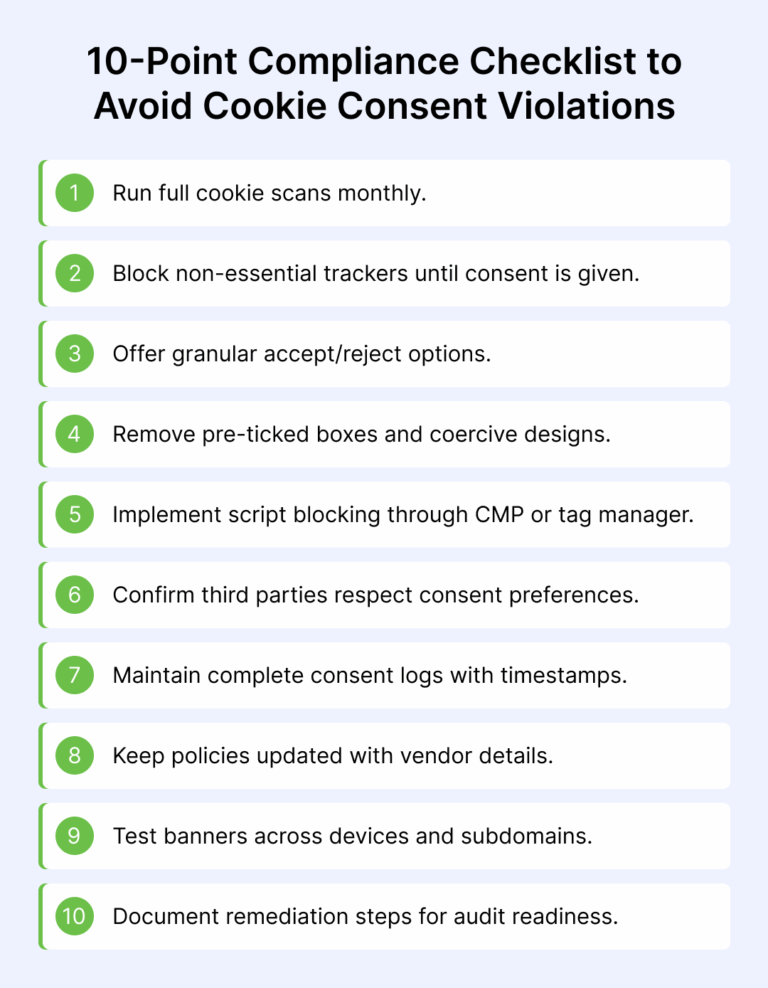2026 is not so far, and Shopify merchants must prepare for stricter privacy rules and smarter advertising platforms. The question is, how will your store maintain accurate ad data and customer trust in this evolving landscape? Cookie banners are no longer just a compliance checkbox; they now shape marketing outcomes and customer perception.
For businesses relying on Shopify, the decision is clear but challenging: should you continue managing banners manually or embrace AI-powered solutions? Making the right choice could directly impact ad performance, compliance, and overall revenue.
This blog explores both approaches, highlights their effects on performance and compliance, and provides a practical roadmap for Shopify merchants to succeed in 2026.
A cookie consent violation occurs when a website collects, processes, or stores user data through cookies or similar tracking technologies without obtaining valid, informed, and freely given consent.
Cookie consent violations typically fall into clear categories:
Cookie consent violations impact more than just legal compliance. They undermine consumer confidence and signal to regulators that your organisation is careless with personal data. These violations carry both financial and brand consequences.
By identifying and fixing violations early, businesses can reduce legal risks and improve transparency. Compliance also fosters trust, which is critical in competitive markets where customer relationships depend on responsible data practices.
Spotting violations requires a structured approach. Businesses should conduct technical checks, policy reviews, and usability tests to ensure compliance across all touchpoints.
Run automated cookie scans to map all trackers on your website. Scanners classify cookies by type and flag unclassified or hidden trackers. Unclassified cookies are a red flag because businesses cannot explain their purpose, making consent invalid. Monthly scans and post-update reviews are best practices.
Audit whether your consent management system records user choices accurately. A proper log should include the timestamp, categories selected, and version of the consent banner displayed. Missing or incomplete logs indicate a serious compliance gap.
Use browser developer tools to verify that scripts only fire after consent. A compliant setup should block analytics, advertising, and tracking cookies until explicit approval. Testing both acceptance and rejection ensures your system correctly enforces consent.
Review your banner against legal requirements. Avoid dark patterns such as pre-ticked boxes, oversized “accept” buttons, or hidden reject options. Regulators in the UK and EU actively penalise such tactics. A compliant banner must offer equal prominence to acceptance and rejection.
Check whether external vendors respect your consent signals. Third parties should only activate their scripts after user consent is granted. Any mismatch between vendor activity and your disclosure creates compliance risks.
Once violations are identified, businesses should prioritise immediate remediation and long-term improvements. A modern Consent Management Platform (CMP) can streamline this process and ensure compliance at scale.
If violations are detected, disable non-essential trackers until they are properly configured. Removing problematic scripts prevents further unauthorised data collection. Document actions taken to demonstrate accountability.
A CMP offers a structured way to correct violations through these steps:

By centralising management in a CMP, businesses reduce errors, simplify updates, and maintain consistent compliance.
Use category-based script blocking to ensure only approved cookies load. Modern consent platforms offer automatic blocking and granular controls. Re-scan your site after fixes to verify that all cookies are properly classified with accurate purpose and retention data.
Tag managers and APIs can enforce consent by controlling when third-party tools activate. Ensure vendors integrate with your consent system so their scripts respect user preferences.
Update your consent banner UX to meet best practices. Provide plain-language descriptions for each cookie category and ensure users have a clear “accept” and “reject” option. Remove pre-ticked boxes and avoid misleading layouts.
Revise your cookie and privacy policies to include accurate vendor lists, cookie durations, and lawful bases for processing. Policies should be transparent and updated regularly.
Embed compliance into contracts by requiring vendors to honour consent frameworks such as IAB TCF. Assign internal ownership for monitoring cookie use and document all remediation steps. A governance model ensures accountability and prepares your business for potential audits.
Verification is as critical as fixing violations. Businesses should:
Testing should include mobile and subdomain environments, where misconfigurations are common.
Cookie consent compliance is not static; it evolves with your site, your vendors, and regulatory updates. Businesses that treat it as a one-off project risk falling behind and facing penalties. By adopting a CMP, running regular scans, testing across platforms, and updating policies, companies can build a resilient compliance framework.
Fixing violations is not only about avoiding fines; it is about earning customer trust, showing accountability, and embedding privacy into your business strategy. In today’s data-driven market, that is the real competitive advantage.
Stay ahead of fines and customer distrust by making compliance effortless. Seers Ai helps you detect, fix, and future-proof cookie consent in just a few clicks.
Start FreeUnder UK GDPR (and PECR), valid cookie consent must be freely given, specific, informed, and unambiguous. Websites must clearly inform users what cookies are used, for what purpose, provide options to accept/reject non-essential cookies, and allow withdrawal. The request must be separate from other terms or settings.
In California, the CCPA/CPRA generally uses an opt-out model rather than an opt-in model for most cookies. If cookies are used for selling or sharing personal data, users must be given a clear “Do Not Sell or Share My Personal Information” link or opt-out method. For minors, explicit opt-in consent is needed in specific circumstances.
GDPR and UK law don’t set fixed retention periods, but require that personal data (including via cookies) be stored no longer than necessary for the original purpose. Once the data is no longer needed, it should be deleted or anonymised. Businesses are expected to define retention periods in their policies.
Non‐essential cookies are those not strictly necessary for the basic functioning of a website. They include analytics, advertising, social media/tracking, and personalisation cookies. If such cookies are employed, consent is required under GDPR / UK law before setting them. Essential cookies (e.g. session, security) don’t require consent.
Yes, settings like browser storage controls or global privacy controls (GPC) can complement consent banners. Under certain laws (like CPRA), opt-out preference signals or browser controls are valid if clearly integrated. But banners are still widely recommended to provide clear, immediate user choices and transparency.
Regulators often issue fines when websites load non-essential cookies prior to consent, use misleading or hurried banners (dark patterns), omit clear opt-out options, or maintain poor records of consent. Penalties range widely depending on the size of the violation and the business, but also include orders to change practices and public reprimands.
 Rimsha Zafar
Rimsha ZafarRimsha is a Senior Content Writer at Seers AI with over 5 years of experience in advanced technologies and AI-driven tools. Her expertise as a research analyst shapes clear, thoughtful insights into responsible data use, trust, and future-facing technologies.
United Kingdom
24 Holborn Viaduct
London, EC1A 2BN

Seers Group © 2025 All Rights Reserved
Terms of use | Privacy policy | Cookie Policy | Sitemap | Do Not Sell or Share My Personal Information.